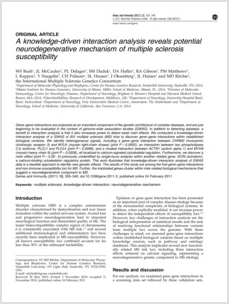Bush WS, McCauley JL, DeJager PL, Dudek SM, Hafler DA, Gibson RA, Matthews PM, Kappos L, Naegelin Y, Polman CH, Hauser SL, Oksenberg J, Haines JL, Ritchie MD, ,.
Gene-gene interactions are proposed as an important component of the genetic architecture of complex diseases, and are just beginning to be evaluated in the context of genome-wide association studies (GWAS). In addition to detecting epistasis, a benefit to interaction analysis is that it also increases power to detect weak main effects. We conducted a knowledge-driven interaction analysis of a GWAS of 931 multiple sclerosis (MS) trios to discover gene-gene interactions within established biological contexts. We identify heterogeneous signals, including a gene-gene interaction between CHRM3 (muscarinic cholinergic receptor 3) and MYLK (myosin light-chain kinase) (joint P0.0002), an interaction between two phospholipase C-β isoforms, PLCβ1 and PLCβ4 (joint P0.0098), and a modest interaction between ACTN1 (actinin alpha 1) and MYH9 (myosin heavy chain 9) (joint P0.0326), all localized to calcium-signaled cytoskeletal regulation. Furthermore, we discover a main effect (joint P5.2E-5) previously unidentified by single-locus analysis within another related gene, SCIN (scinderin), a calcium-binding cytoskeleton regulatory protein. This work illustrates that knowledge-driven interaction analysis of GWAS data is a feasible approach to identify new genetic effects. The results of this study are among the first gene-gene interactions and non-immune susceptibility loci for MS. Further, the implicated genes cluster within inter-related biological mechanisms that suggest a neurodegenerative component to MS.

